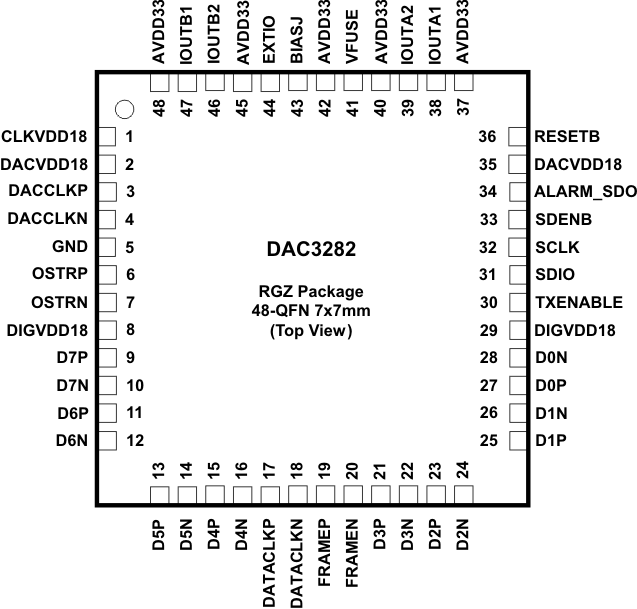SLAS646C December 2009 – May 2015 DAC3282
PRODUCTION DATA.
- 1 Features
- 2 Applications
- 3 Description
- 4 Revision History
- 5 Pin Configuration and Functions
-
6 Specifications
- 6.1 Absolute Maximum Ratings
- 6.2 ESD Ratings
- 6.3 Recommended Operating Conditions
- 6.4 Thermal Information
- 6.5 Electrical Characteristics - DC Specifications
- 6.6 Electrical Characteristics - AC Specifications
- 6.7 Electrical Characteristics - Digital Specifications
- 6.8 Timing Characteristics
- 6.9 Typical Characteristics
-
7 Detailed Description
- 7.1 Overview
- 7.2 Functional Block Diagram
- 7.3
Feature Description
- 7.3.1 Input FIFO
- 7.3.2 FIFO Alarms
- 7.3.3 FIFO Modes of Operation
- 7.3.4 Dual Sync Sources Mode
- 7.3.5 Single Sync Source Mode
- 7.3.6 Bypass Mode
- 7.3.7 Data Pattern Checker
- 7.3.8 FIR Filters
- 7.3.9 Coarse Mixer
- 7.3.10 Digital Offset Control
- 7.3.11 Temperature Sensor
- 7.3.12 Sleep Modes
- 7.3.13 Reference Operation
- 7.4 Device Functional Modes
- 7.5 Programming
- 7.6
Register Maps
- 7.6.1 CONFIG0 (address = 0x00) [reset = 0x70]
- 7.6.2 CONFIG1 (address = 0x01) [reset = 0x11]
- 7.6.3 CONFIG2 (address = 0x02) [reset = 0x00]
- 7.6.4 CONFIG3 (address = 0x03) [reset = 0x10]
- 7.6.5 CONFIG4 (address = 0x04) [reset = 0xFF]
- 7.6.6 CONFIG5 (address = 0x05) READ ONLY
- 7.6.7 CONFIG6 (address =0x06) [reset = 0x00]
- 7.6.8 CONFIG7 (address = 0x07) [reset = 0x00] (WRITE TO CLEAR)
- 7.6.9 CONFIG8 (address = 0x08) [reset = 0x00] (WRITE TO CLEAR)
- 7.6.10 CONFIG9 (address = 0x09) [reset = 0x7A]
- 7.6.11 CONFIG10 (address = 0x0A) [reset = 0xB6]
- 7.6.12 CONFIG11 (address = 0x0B) [reset = 0xEA]
- 7.6.13 CONFIG12 (address =0x0C) [reset = 0x45]
- 7.6.14 CONFIG13 (address =0x0D) [reset = 0x1A]
- 7.6.15 CONFIG14 Register Name (address = 0x0E) [reset = 0x16]
- 7.6.16 CONFIG15 Register Name (address = 0x0F) [reset = 0xAA]
- 7.6.17 CONFIG16 (address = 0x10) [reset = 0xC6]
- 7.6.18 CONFIG17 (address = 0x11) [reset = 0x00]
- 7.6.19 CONFIG18 (address = 0x12) [reset = 0x02]
- 7.6.20 CONFIG19 (address = 0x13) [reset = 0x00]
- 7.6.21 CONFIG20 (address = 0x14) [reset = 0x00] (CAUSES AUTOSYNC)
- 7.6.22 CONFIG21 (address = 0x15) [reset = 0x00]
- 7.6.23 CONFIG22 (address = 0x16) [reset = 0x00]
- 7.6.24 CONFIG23 (address = 0x17) [reset = 0x00]
- 7.6.25 CONFIG24 (address = 0x18) [reset = 0x83]
- 7.6.26 CONFIG25 (address = 0x19) [reset = 0x00]
- 7.6.27 CONFIG26 (address = 0x1A) [reset = 0x00]
- 7.6.28 CONFIG27 (address =0x1B) [reset = 0x00]
- 7.6.29 CONFIG28 (address = 0x1C) [reset = 0x00]
- 7.6.30 CONFIG29 (address = 0x1D) [reset = 0x00]
- 7.6.31 CONFIG30 (address = 0x1E) [reset = 0x00]
- 7.6.32 VERSION31 (address = 0x1F) [reset = 0x43] (READ ONLY)
- 8 Application and Implementation
- 9 Power Supply Recommendations
- 10Layout
- 11Device and Documentation Support
- 12Mechanical, Packaging, and Orderable Information
5 Pin Configuration and Functions
RGZ Package
48-Pin VQFN with Thermal Pad
Top View
